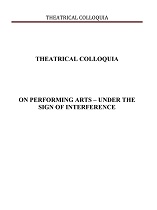Essence and Expressivity - Body Limitations from Visuality to Movement Technique
Essence and Expressivity - Body Limitations from Visuality to Movement Technique
Author(s): Beatrice VolbeaSubject(s): Theatre, Dance, Performing Arts
Published by: Editura ARTES
Keywords: gesture; expressivity; theatre-dance; theatre biomechanics
Summary/Abstract: The present topic is unquestionably not a random choice. It is the result of a genuine need to explore the drama formula based on the specific body language that does not arise from psychological analysis, but from the expressivity of the human body and an appropriate understanding of the language of stage movement.Both playing on stage and dancing require total control and usage of the body. In order to achieve this and to have the necessary impact on the audience, the actor and the dancer have to train constantly and to stay connected to their thinking and imagination, as the body is a composition ground full of mysteries, a stage in itself. No doubt, an artist can reach the essence by accident, if this is the way he has assumed; dancing, that has its specific characteristics as compared to other arts, can undoubtedly answer to many of the questions that arise from the issues that stage movement involves.I have approached the present topic of body usage as drama students are taught to treat their body as an instrument that can be perfected to answer the requirements and the standards of stage movement. I will refer to both the actor’s and the dancer’s movement technique as opposed to his genetic body expressivity in a given context. Starting from his inner self and the ephemeral illusion of total control that both influence and determine every movement in a specific area, the artist’s point of view becomes challenging in relation to the perception of reality. His identity, the memory of his body and his very presence in a particular circumstance determine movement limitations that become both message and ground to body visuality. The meaningless body in search of a new content brings together the two arts that are the result of reality intermingling with poetry and generates a genuine identity, the theatre-dance. I will focus more on the specific language of the theatre-dance as it relates to both physical and mental challenges. Beyond meaning and visuality there is the training technique that is exhausting and highly repetitive at times. At present, drama and dance performances that result from a large series of artistic and aesthetic tendencies aim at designing a new perspective on the human body with all its political, social and emotional levels.
Journal: Colocvii teatrale
- Issue Year: 2015
- Issue No: 19
- Page Range: 237-246
- Page Count: 10

